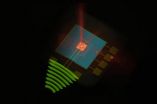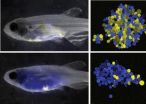(Press-News.org) Ever worry about losing your mobile-phone reception? The problem is a weak microwave signal. The same problem hampers cosmologists looking at the early universe, a glimpse embodied in the cosmic microwave background. Or take a pressing earthly example: oncologists often locate and identify tumors using MRI scans. All three of these efforts---communications, cosmology, medicine---depend on discriminating weak microwave or radio signals from a noisy environment. A new approach to this important problem provides a clean, all-optical detection of microwaves and radiowaves featuring noise mitigation a thousand times better than existing methods.
The new detector was just developed by a collaboration of scientists from the Niels Bohr Institute at the University of Copenhagen, the Technical University of Denmark, and the Joint Quantum Institute (1). The building and testing of this first all-optical detection of radio waves is reported in the 6 March 2014 issue of the journal Nature (2).
QUANTUM MICROPHONES
The detector works like this: radio waves strike an antenna which constitutes one element in an electronic circuit. Another element in that circuit is a capacitor, one of whose electrodes consists of a flexible membrane. Light at visible frequencies reflects off the back side of this membrane. Depending on the radio signal arriving just then at the antenna, the silicon-nitride membrane (coated with a 50-nm-thick film of silver) mechanically alters its shape accordingly. This in turn modulates the visible light waves in a consistent way. Thus a radio signal, typically in the megahertz range (10^6 Hz), can be converted into an optical signal, typically in the hundreds of terahertz range (10^14 Hz).
This up-conversion from radio to optical has several advantages. First, it allows a radio signal to be transduced into light and shot down an optical fiber rather than being sent down a copper wire, where it would suffer considerable energy loss. The radio-optical conversion will also help facilitate the development of devices that handle quantum information. In a regular microphone, sound is converted into electrical signals sent down a wire. In the analogous quantum microphone, quantum information could be interconverted between radio and optical waves alternatively for transport or processing.
NOISE ABATEMENT
Second, and no less important, is the mitigation of noise. Radio waves were a boon for communications, starting with Marconi and the first "wireless" transmission of information in the early 20th century. As radio electronics grew in sophistication scientists and engineers became more and more concerned with Johnson noise, the ubiquitous radio noise present by virtue of the simple fact that Earth's surface is a warm place; our world positively glows in radio waves. Named for Bell Labs researcher John B. Johnson, this thermal noise competes with whatever radio signals are being processed in devices. One can amplify a weak signal, but the noise gets amplified along with the signal.
Even more unwanted noise is added in the amplifiers that bring the signal to a level at which it can be processed. For years special transistors have accomplished this task. One major drawback of this approach has been the need to chill the converters to cryogenic temperatures to reach their best performance. One example of this kind of device is the one used on the orbiting Planck Telescope, which maps the microwave background. When the craft's coolant is depleted, the mission ends.
The new device not only produces a much higher degree of noise reduction but it does this at room temperature, thus obviating the need for cryogenics. The development is based upon prior theoretical work by the same collaboration (3). "This device is the first room-temperature transducer of radio waves to optical waves at the quantum level and the first to entail a threefold electrical-mechanical-optical conversion. Previous efforts have bridged the electrical and mechanical or the mechanical and optical, but not all three realms," said the lone JQI participant, theorist Jacob Taylor.
Taylor says that the whole up-conversion process can be done in reverse. Again for the purpose of quantum communication, there might be occasion to convert microwave or radio signals into optical form and then back into radio after transmission from one quantum device to another.
A team leader on the new detector effort is Albert Schliesser of the Niels Bohr Institute in Copenhagen. He describes the detector this way: "In the first place, this is a completely new way to measure electrical signals: making them excite a tiny membrane which we monitor with laser light. It may sound surprising, but this approach is so sensitive that it can out-perform conventional electronic amplifiers. That means, for example, that it could be a new way of getting clearer MRI images, or maps of the sky recorded by radio telescopes. We are currently trying to extend our work---which so far is really just a demonstrator of the concept---to attain a smaller detector which is more sensitive and capable of handling a wider band of radio signals."
INFORMATION:
(1) The Joint Quantum Institute is operated jointly by the National Institute of Standards and Technology in Gaithersburg, MD and the University of Maryland in College Park.
(2) Optical detection of radio waves through a nanomechanical transducer, T. Bagci, A. Simonsen, S. Schmid, L. G. Villanueva, E. Zeuthen, J. Appel, J. M. Taylor, A. Sørensen, K. Usami, A. Schliesser, and E. S. Polzik, Nature 6 March 2014
(3) Physical Review Letters, 2011, 2011 PRL? http://journals.aps.org/prl/abstract/10.1103/PhysRevLett.107.273601
Jacob Taylor, jmtaylor@umd.edu
Albert Schliesser, albert.schliesser@nbi.dk
Written by Phillip F. Schewe at JQI, pschewe@umd.edu, 301-405-0989. http://jqi.umd.edu/
Up-converted radio
The way to treat radio waves in a noisy environment is to turn them into visible light
2014-03-06
ELSE PRESS RELEASES FROM THIS DATE:
Discovery sheds new light on marijuana's anxiety relief effects
2014-03-06
An international group led by Vanderbilt University researchers has found cannabinoid receptors, through which marijuana exerts its effects, in a key emotional hub in the brain involved in regulating anxiety and the flight-or-fight response.
This is the first time cannabinoid receptors have been identified in the central nucleus of the amygdala in a mouse model, they report in the current issue of the journal Neuron.
The discovery may help explain why marijuana users say they take the drug mainly to reduce anxiety, said Sachin Patel, M.D., Ph.D., the paper's senior ...
Some people really just don't like music
2014-03-06
It is often said that music is a universal language. However, a new report in the Cell Press journal Current Biology on March 6 finds that music doesn't speak to everyone. There are people who are perfectly able to experience pleasure in other ways who simply don't get music in the way the rest of us do.
The researchers refer to this newly described condition as specific musical anhedonia—in other words, the specific inability to experience pleasure from music.
"The identification of these individuals could be very important to understanding the neural basis of music—that ...
'Seeing' bodies with sound (no sight required)
2014-03-06
People born unable to see are readily capable of learning to perceive the shape of the human body through soundscapes that translate images into sound, according to researchers who report their findings in the Cell Press journal Current Biology on March 6. With a little training, soundscapes representing the outlines and silhouettes of bodies cause the brain's visual cortex—and specifically an area dedicated in normally sighted people to processing body shapes—to light up with activity.
With no more than 70 hours of training on average, study participants could recognize ...
Common mutation is culprit in acute leukemia relapse
2014-03-06
Harvard stem cell scientists have identified a mutation in human cases of acute lymphoblastic leukemia that likely drives relapse. The research, published in Cancer Cell, could translate into improved patient care strategies for this particular blood cancer, which typically affects children but is more deadly in adults.
In recent years, a trend toward single-cell analysis has shown that individual cells within a tumor are capable of amassing mutations to make them more aggressive and treatment resistant. So while 99% of a tumor may be destroyed by the initial treatment, ...
Warming temperatures are pushing 2 chickadee species -- and their hybrids -- northward
2014-03-06
The zone of overlap between two popular, closely related backyard birds is moving northward at a rate that matches warming winter temperatures, according to a study by researchers from the Cornell Lab of Ornithology, Villanova University, and Cornell University. The research will be published online in Current Biology on Thursday, March 6, 2014.
In a narrow strip that runs across the eastern U.S., Carolina Chickadees from the south meet and interbreed with Black-capped Chickadees from the north. The new study finds that this hybrid zone has moved northward at a rate ...
Obese adolescents not getting enough sleep?
2014-03-06
Cincinnati, OH, March 6, 2014 -- Lack of sleep and obesity have been associated with an increased risk of cardiovascular and metabolic diseases in adults and young children. However, the association is not as clear in adolescents, an age group that is known to lack adequate sleep and have an overweight and obesity prevalence rate of 30% in the US. In a new study scheduled for publication in The Journal of Pediatrics, researchers found that cardiometabolic risk in obese adolescents may be predicted by typical sleep patterns.
Heidi B. IglayReger, PhD, and colleagues from ...
Establishing standards where none exist; Harvard researchers define 'good' stem cells
2014-03-06
After more than a decade of incremental – and paradigm shifting, advances in stem cell biology, almost anyone with a basic understanding of life sciences knows that stem cells are the basic form of cell from which all specialized cells, and eventually organs and body parts, derive.
But what makes a "good" stem cell, one that can reliably be used in drug development, and for disease study? Researchers have made enormous strides in understanding the process of cellular reprogramming, and how and why stem cells commit to becoming various types of adult cells. But until now, ...
Dr. Brenna Anderson contributes to expert series on GAS in pregnancy
2014-03-06
Ignaz Semmelweiss made one of the most important contributions to modern medicine when he instituted hand washing in an obstetric clinic in Austria in 1847, decreasing mortality there from more than ten percent to two percent. Unfortunately, infections can still occur in pregnancy and during delivery and can have associated mortality rates of up to 30 to 50 percent if not treated quickly and properly.
Brenna Anderson, MD, director of the Women's Infectious Diseases Consultative Service at Women & Infants of Rhode Island and an associate professor of obstetrics and gynecology ...
Study identifies gene important to breast development and breast cancer
2014-03-06
Significance: Understanding more about how the different types of cells in breast tissue develop improves our knowledge of breast cancer. TAZ represents a potential new target for drug therapies to treat aggressive types of breast cancer.
Background: In cancer, normal cells can become unpredictable or aggressive and thus difficult to treat with anti-cancer drugs. This is especially true in breast cancer. By identifying the genes responsible for this change in cells from breast tissue, researchers hope to identify a way to stop or reverse it.
In breast tissue, there ...
Are you smarter than a 5-year-old? Preschoolers can do algebra
2014-03-06
Millions of high school and college algebra students are united in a shared agony over solving for x and y, and for those to whom the answers don't come easily, it gets worse: Most preschoolers and kindergarteners can do some algebra before even entering a math class.
In a recently published study in the journal Developmental Science, lead author and post-doctoral fellow Melissa Kibbe and Lisa Feigenson, associate professor of psychological and brain sciences at Johns Hopkins University's Krieger School of Arts and Sciences, find that most preschoolers and kindergarteners, ...
LAST 30 PRESS RELEASES:
Support for parents with infants at pediatric check-ups leads to better reading and math skills in elementary school
Kids’ behavioral health is a growing share of family health costs
Day & night: Cancer disrupts the brain’s natural rhythm
COVID-19 vaccination significantly reduces risk to pregnant women and baby
The role of vaccination in maternal and perinatal outcomes associated with COVID-19 in pregnancy
Mayo Clinic smartwatch system helps parents shorten and defuse children's severe tantrums early
Behavioral health spending spikes to 40% of all children’s health expenditures, nearly doubling in a decade
Digital cognitive behavioral treatment for generalized anxiety disorder
Expenditures for pediatric behavioral health care over time and estimated family financial burden
Air conditioning in nursing homes and mortality during extreme heat
The Alps to lose a record number of glaciers in the next decade
What makes a good proton conductor?
New science reporting guide published for journalists in Bulgaria
New international study reveals major survival gaps among children with cancer
New science reporting guide published for journalists in Turkey
Scientists develop a smarter mRNA therapy that knows which cells to target
Neuroanatomy-informed brain–machine hybrid intelligence for robust acoustic target detection
Eight SwRI hydrogen projects funded by ENERGYWERX
The Lundquist Institute and its start-up company Vitalex Biosciences Announces Strategic Advancement of Second-Generation fungal Vaccine VXV-01 through Phase 1 Trials under $40 Million Competitive Con
Fine particles in pollution are associated with early signs of autoimmune disease
Review article | Towards a Global Ground-Based Earth Observatory (GGBEO): Leveraging existing systems and networks
Penn and UMich create world’s smallest programmable, autonomous robots
Cleveland researchers launch first major study to address ‘hidden performance killer’ in athletes
To connect across politics, try saying what you oppose
Modulating key interaction prevents virus from entering cells
Project explores barriers to NHS career progression facing international medical graduates
Jeonbuk National University researchers explore the impact of different seasonings on the flavor perception of Doenjang soup
Two Keck Medicine of USC Hospitals named Leapfrog Top Teaching Hospitals
World-first discovery uncovers how glioblastoma tumours dodge chemotherapy, potentially opening the door to new treatments
A fatal mix-up: How certain gut bacteria drive multiple sclerosis
[Press-News.org] Up-converted radioThe way to treat radio waves in a noisy environment is to turn them into visible light



